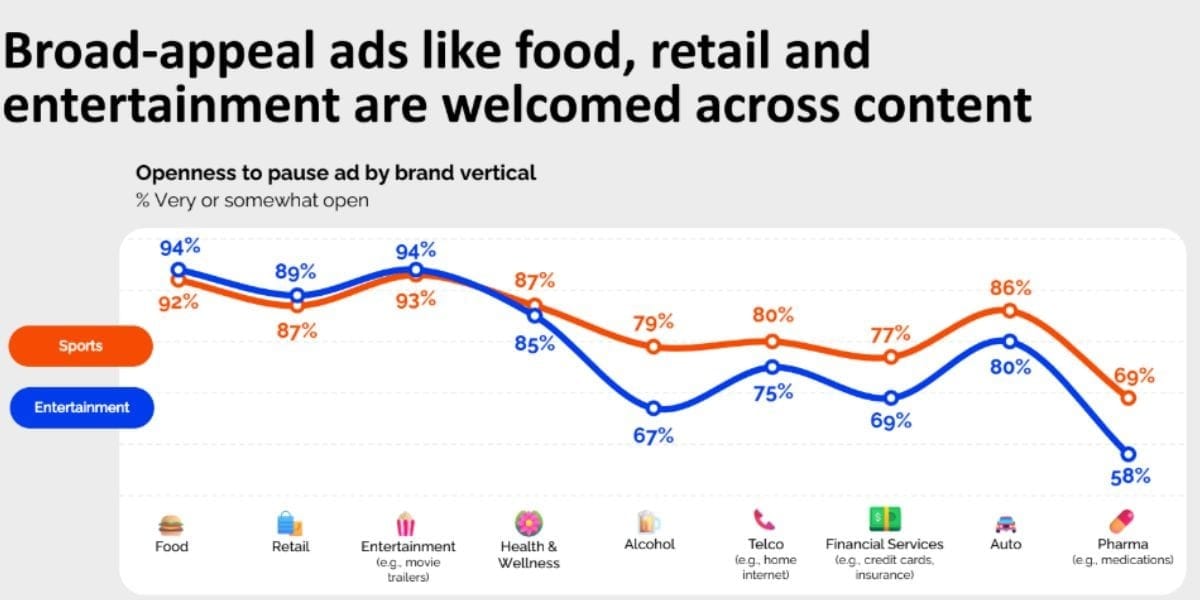Why Pause Ads Are Popular, According To New DirecTV/Magna Study
'We pause for various reasons whether it be to grab a snack, check a message, or process what just happened on screen, but what remains consistent is that we’re still engaged,' said Magna's Kara Manatt. 'That’s a valuable moment for brands to stay top of mind.'

Streaming services have been ramping up the number of commercials that air per hour. For consumers who flocked to streaming because it was commercial free, that’s a bit of a bummer.
Now subscribing to a streaming service with ads is cheaper than their commercial free versions, but the distractions and interruptions that plagued TV viewers are back as profitability becomes the most important metric for direct-to-consumer streaming services.
Naturally, some commercials are less bothersome than others. Seeing the same ad over and over again in the same show will be annoying, no matter how entertaining the ad was when you first saw it during the Super Bowl.
Overall the streaming industry has contended that viewers don’t mind commercials that are relevant. Don’t serve cat owners dog food ads. Young women don’t need to see erectile dysfunction ads. Technology promises to deliver pertinent (if not entertaining) ads and control frequency. But as any viewer could tell you, those promises aren’t being kept right now.
Technology is also enabling a variety of ad formats that promise to be more engaging than traditional 30-second spots. Some are interactive, offering more information or discounts to viewers who click with their remote control or scan a QR code. Others are shoppable for viewers who like to buy things while sitting on their couch. Some ads even promise that if you sit through this one commercial, we won’t show you any more for the rest of the show.
But the ad format that seems to be getting the most attention from media companies and advertisers is the pause ad.
You’ve probably seen a pause ad. You’re watching a show or movie and need to get a snack or go to the bathroom, so you hit pause. With pause ads, instead of watching a frozen screen, an ad appears, with usually some sort of pause pun in addition to a brand message.
At a time when the number of commercials per hour on streaming services is growing, a new study, The Pause: Reaching TV Viewers During Can’t-Miss Moments, from Magna Media Trials and DirecTV, surveyed viewers to find out why pause ads are popular.
DirecTV, which is pivoting from satellite to streaming, recently announced that it was making pause ads buyable via programmatic technology.
“This latest research shows that pausing is the exact opposite of disengaging. People pause because they are highly engaged in the content they’re watching and either don’t want to miss it, don’t want someone else in the household to miss it, or want to rewind and watch it again to make sure they caught everything,” said Drew Groner, senior VP, head of sales & marketing, DirecTV Advertising. “And now that pause ads can be bought programmatically, it’s easier than ever for brands to reach viewers during those can’t-miss moments.”
In the study 2,427 people who had watched ad-supported TV in the past 24 hours were asked to keep a media diary and answer questions about their pause behavior.
The first thing the survey found was that pausing is a natural behavior among viewers, with 91% of people saying they pause all the time while watching streaming TV and 70% saying they pause all the time while watching traditional TV.
Across all generations, viewers said that they were open to seeing ads while their shows were paused. Among Gen Z, Millennials and Gen X more than 70% were very or somewhat open to ads during pauses. Also 59% of boomers felt that way.
The survey also found that viewers who pause are engaged, not distracted. They wanted to avoid missing an important scene or were watching with someone else to watch with them. Some even wanted to rewind and rewatch a part of the show.
That pausing behavior shows up among viewers watching both sports and entertainment.
Surprisingly one-third of those who pause content continue watching what’s on the screen. And those pauses last a lot longer than 15-second spots, or even 30-second commercials.
Only 8% of those surveyed said their pauses were shorter than 30 seconds and 24% said their pauses were 30 seconds to 1 minute. The majority said their pauses were longer than a minute and 3% said their pauses lasted more than 15 minutes. And during pauses of all lengths, 63% of viewers said they prefer to see a pause ad to a frozen screen.
Viewers are poised to pause ads for products in a long list of categories notably including food, retail, entertainment, health & welfare, autos, telcos, and financial services.

Pause ads really get viewers' attention when they’re linked to the viewing experience. Viewers said they were most open to ads for food and snacks. During sports programming, ads for sports gear are cool. And discounts and deals are almost always appreciated.
The report concludes that pause ads are particularly good for introducing viewers to new products, and viewers like the ability to save offers and reminders, product recommendations that fit with what’s being watched, a way to click to go to a brand’s web site or a QR code that give the viewer an opportunity to learn more about a product.
And pause ads work. Last month, when DirecTV and TripleLift announced that pause ads on DirecTV would be available to programmatic buyers, DirecTV said that according to its internal metrics, pause ads drove 34% higher unaided ad recall compared to traditional addressable advertising and 6% more incremental reach when paired with addressable.
It stands to reason that DirecTV would know a thing or two about pause ads. It earned a patent on its pause ads in 2021 and won an Emmy for the non-disruptive format in 2024.
“As viewers, we pause for various reasons whether it be to grab a snack, check a message, or process what just happened on screen, but what remains consistent is that we’re still engaged,” said Kara Manatt, executive VP, Intelligence Solutions at Magna. “That’s a valuable moment for brands to stay top of mind.”

